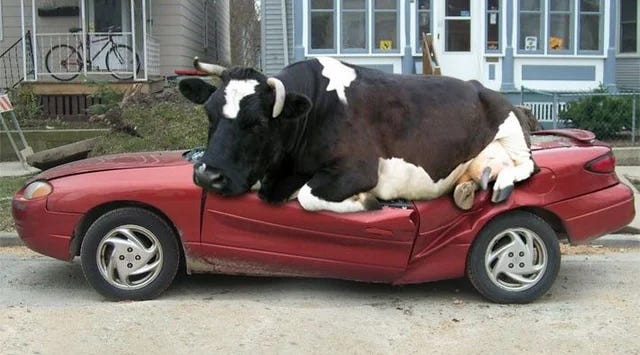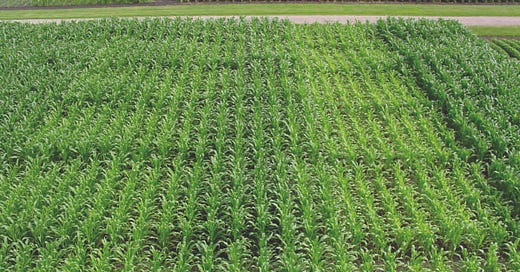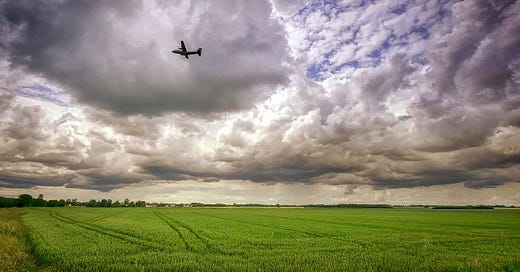
Discover more from Ag Data News
Cow Poop is Now a Big Part of California Fuel Policy
Are the state’s new low-carbon fuel regulations full of BS?
Every day, California farmers milk 1.7 million cows. Each cow generates about 7 gallons of milk and 100 gallons of waste. Most farmers process the waste (mostly manure) by washing it into lagoons where microbes break it down and, in the process, emit methane, a potent greenhouse gas.
These facts raise two questions. First, can we prevent the manure-eating microbes from sending methane into the atmosphere? Second, can we capture the methane and use it for energy?
California has answered yes to both questions. On the first question, it aims to reduce methane emissions from livestock manure by 40% below 2013 levels by 2030 (codified in SB 1383). One way to achieve this goal would be to place the burden on farmers by charging them a methane emissions fee or requiring them to use practices or technologies that reduce methane emissions. This approach would raise the cost of producing milk and therefore increase the price consumers pay for dairy products. The cost increase may cause some farmers to move out of state, taking their methane emissions with them. This response, known as leakage, arises in many environmental policies, including in California’s cap and trade program, as explained by Meredith in this blog.
California has chosen a different path. It has shoehorned dairy methane into a transportation program: the low carbon fuel standard (LCFS). This structure avoids leakage, but it makes consumers and producers of gasoline and diesel pay for reductions in dairy manure emissions.
Manure in the LCFS
To capture methane from manure lagoons, farmers install anaerobic digesters, which are essentially giant covers that seal manure in the lagoon to keep oxygen out while microbes feed on the contents. The captured methane — known as biogas — is then cleaned and injected into a natural gas pipeline, from which it has multiple uses including fueling a natural-gas powered vehicle and generating electricity.
This dairy biogas earns LCFS credits because it is considered a low carbon fuel. The LCFS sets a target for the average carbon intensity of transportation fuels consumed in the state. Fuels that are more carbon intensive than the target accrue deficits that must be balanced by credits earned by fuels that are less carbon intensive. The figure below shows that gasoline and diesel producers generate deficits, which they can offset by buying credits from producers of biogas and other lower-GHG fuels like electricity and renewable diesel.

In the most recent LCFS data, dairy biogas contributed almost 20% of the credits in the LCFS program, yet it provided less than 1% of energy used for transportation. Dairy biogas has an outsized impact in the LCFS because it is treated very differently than most fuels. Last month’s proposed LCFS amendments indicate that this differential treatment will continue.
The LCFS Assigns Dairy Biogas a Large Negative Carbon Intensity
Carbon intensity is the number of grams of carbon dioxide emissions produced per megajoule of energy. The California Air Resources Board (CARB) calculates this number for each fuel source using a life cycle analysis that accounts for tailpipe emissions as well as potential emissions throughout the fuel production process. For example, petroleum gasoline has a carbon intensity of 100.82 and an electric car powered by solar-generated electricity has a carbon intensity of zero. Most other fuels have carbon intensities between zero and 100.
The carbon intensity of dairy biogas ranges between -102.79 and -790.41 depending on characteristics of the digester. The current average carbon intensity for dairy biogas is -269.
CARB assigns dairy biogas a negative carbon intensity because it gives credit for preventing methane emissions that would otherwise have occurred. Their argument is that, if a farmer had not installed a digester on a manure lagoon, then it would have sent methane into the atmosphere.
Microbes produce different amounts of gas inside a digester than they would in an open lagoon because of differing environmental factors such as oxygen exposure and temperature. The carbon intensity number is determined by the estimated emissions from the open lagoon (avoided methane) per unit of biogas produced. For example, in highly productive digesters, the amount of prevented methane is low as a proportion of the biogas produced, so such a digester would get a relatively small negative carbon intensity.
In the LCFS, fuels with a negative carbon intensity are very helpful in meeting the policy target because they can offset a lot of high-carbon fuel. For example, adding one average biogas-powered vehicle to the fleet would produce enough LCFS credits to cover the deficits incurred by 26 similar gasoline-powered vehicles.
This accounting scheme is one reason why dairy biogas has increased from almost non-existent five years ago to half of all natural gas used for transportation in the state. The other half is contributed by biogas captured from landfills. However, landfill gas gets a carbon intensity of 53 because it does not get credit for avoided-methane emissions. So, even though its fuel volumes are similar to dairy, it generates only a fraction of the credits, as shown in the figure below. Biogas can also earn LCFS credits by generating hydrogen or electricity for use in transportation, but these pathways have been used very little so far.

Costs and Benefits of Anaerobic Digesters
In this 2023 Ag Data News article, I showed that the cost of an anaerobic digester is about 10 times the market value of the gas it produces. A representative new digester costs about about $1130 per milking cow per year, comprising $490 in capital costs and $440 in operating costs, plus $200 in trucking costs if unable to connect directly to a gas pipeline. In 2023, revenue from selling gas was about $128, for a net cost of about $1000 per milking cow per year. This representative digester has a carbon intensity of -355, which corresponds to about 6 metric tons of CO2 equivalent emissions per milking cow per year.
So, for $1000 we reduce CO2 emissions by 6 metric tons, or $167 per ton.
Methane is a far more powerful greenhouse gas than CO2, but it doesn’t last nearly as long in the atmosphere. There is a vigorous scientific debate over how best to convert methane emissions into CO2 equivalent accounting for both how much it warms and when. Using an alternative approach would reduce the estimated emissions reduction by a factor of three and therefore raise the cost per ton by a factor of three. Moreover, all these numbers assume that CARB correctly estimates the amount of prevented emissions.
Incentives Facing Farmers
Anaerobic digesters receive government support through three programs. First, using proceeds from the state’s cap and trade program, the California Department of Food and Agriculture offers grants to cover up to half the capital costs of building digesters. Second, sellers of dairy biogas generate credits in the federal renewable fuel standard (known as RINs). Third, they earn LCFS credits.
Between mid 2018 and the end of 2021, revenues from selling biogas and the associated RIN and LCFS credits were approximately double the cost of installing and running a typical digester, as shown in the figure below. LCFS credit prices have declined in the last two years, making the typical digester closer to a break even proposition. If and when credit prices go back up, then the profits will return.
High profits from operating digesters create the incentive for farmers to expand dairy herds for the purpose of generating manure rather than for producing milk. Between 2014 and 2019, California dairy cow numbers declined by 50,000 while the number of cows in other western states increased by 100,000 (see figure below). Since 2019, cow numbers have been relatively flat throughout the west.
It is possible that the advent of digesters in California stemmed the flow of cows out of the state. Dairy farmers outside California can access only two of the three digester programs accessible to California farmers. They are eligible to earn LCFS and RIN credits for their biogas, but they cannot receive California Department of Food and Agriculture grants to cover capital costs. Whether this grant funding is the difference between leaving and staying in California is an important topic for further research given the potential for emissions leakage if the state were to remove negative crediting but still require farmers to reduce manure methane emissions as per SB 1383.
What Next?
CARB is proposing several amendments to the LCFS. It considered removing the negative crediting of dairy biogas projects, but its proposal (which is currently out for comment) opted to continue negative credits until 2040 for biogas used directly in transportation and until 2045 for biogas used to produce hydrogen for transportation.
There is a long tradition in agriculture of governments paying farmers for environmental improvement, rather than placing the burden on farmers to make those improvements. As a result, consumers do not see the full cost to society of the food they eat. Instead, those costs are shifted to taxpayers or, in the case of dairy biogas, gasoline and diesel consumers. Such mispricing can cause costly misallocations of resources, as articulated often on this blog.
Leakage is the main argument given for continuing negative crediting. There are several ways to mitigate leakage. Some, such as border adjustments (tax dairy products coming into California) would be very difficult to operationalize. A good rule in policy is to directly target the problem you are trying to solve. In this case, the problem would be methane-mitigation costs imposed on farmers that cause them to move out of state. Negative crediting in the LCFS is a convoluted solution with numerous drawbacks. A direct solution could involve the state sharing the costs of methane mitigation practices, which they already do to some extent through California Department of Food and Agriculture programs.
I made the last three figures using this R code. This article is cross posted at the Energy Institute blog.





















I see that a lot of the movement out of state started in 2015. Could that be related to drought rather than methane mitigation regulation?